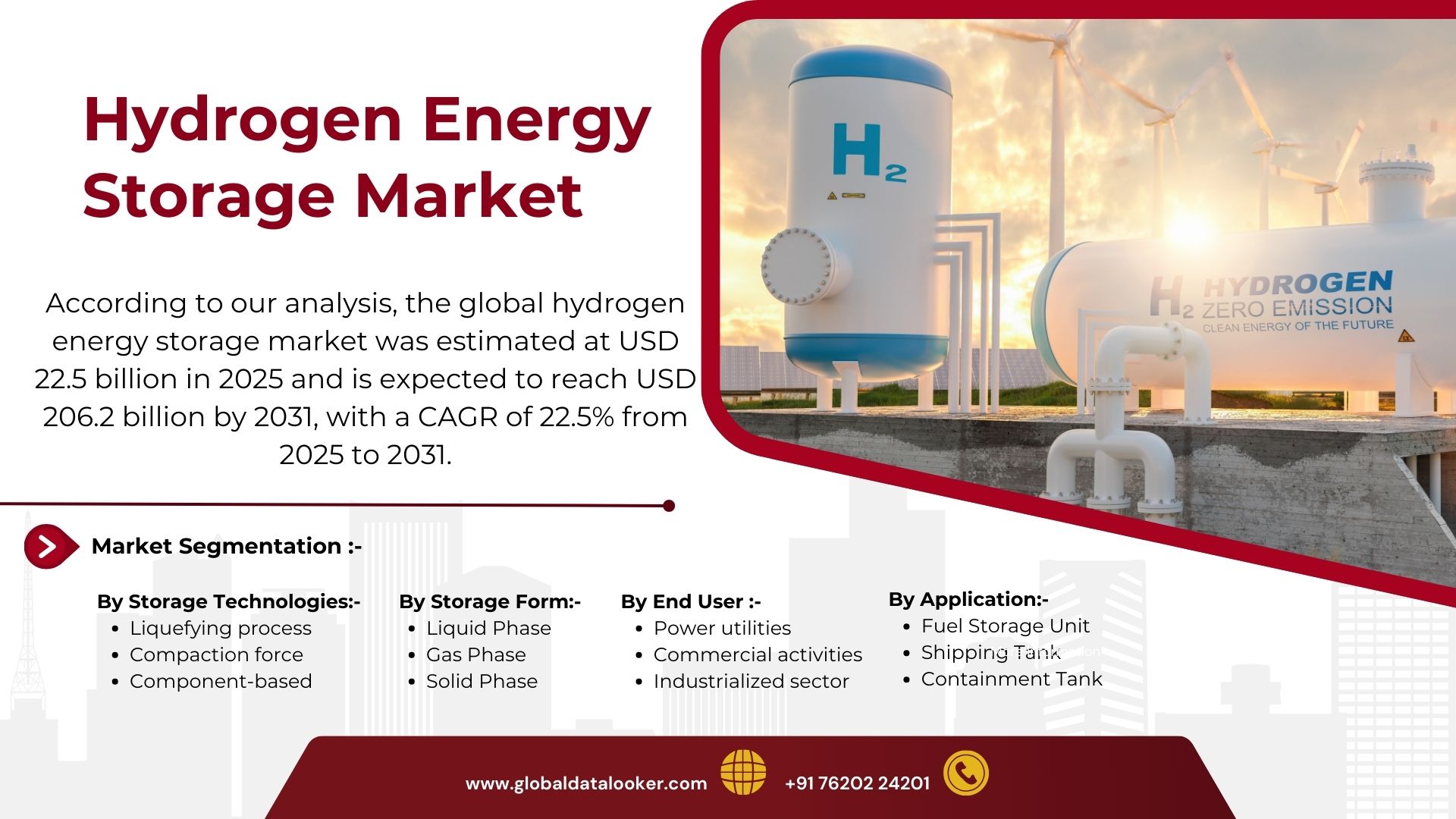Global Hydrogen Energy Storage Market to Reach $206.2 Billion by 2031 Growing at a CAGR of 22.5%

The Global hydrogen energy storage market is on a huge growth trajectory, which is estimated to reach USD 206.2 billion by 2031. This exponential growth is not merely a trend, but a seismic change in energy storage.
Storage of hydrogen is increasingly required as countries attempt to cut carbon and move away from fossil fuels. Because hydrogen can store surplus renewable energy from solar and wind, it could ensure a cleaner future without all the complications associated with the existing energy infrastructure. We will explore in this blog post, why this incredible development of the hydrogen energy storage market, key segments, players driving the market, and look at the potential and threats for the future. Join us as we take a look at one of the most dynamic markets of our times!
Key Factors Driving the Growth of the Market
The market for hydrogen energy storage is growing extremely fast due to a number of reasons. The drive to deliver sustainable energy fuels investment in clean technologies. If countries want to be more carbon neutral, hydrogen can provide a solution. It is important to look also at the work of the state through policy and programmes. All of these states are supporting hydrogen research and development and therefore it is a lucrative field for investors. Technological advancements also contribute significantly. Electrolyser and fuel cell technology can be enhanced to make the production processes more efficient, cheaper and larger. Furthermore, as renewable energy expands, efficient storage becomes necessary. Hydrogen can stand in between the intermittent source of solar or wind energy and the recurrent consumption.
Increasing climate awareness pushes industries to adopt green solutions such as hydrogen fuel cells. Such interconnected momentum is setting the market for big growth over the next few years.
Analysis of Various Segments in the Market
Global hydrogen energy storage market has various segments, which plays a different role in the growth. The main applications are transportation, industry and energy production. For vehicles, hydrogen fuel cells are growing as a more sustainable alternative to fossil fuels. This is a popular segment with developing nations aiming at more sustainable options. Industrial application is another important domain. Industrial processes use hydrogen storage to minimize their carbon footprint and ensure they have reliable energy at peak demand times. Generation is a fundamental aspect of this market as well. Store surplus renewable power as hydrogen, which supports flexible power delivery and stability on the grid. Innovations such as solid state storage and liquid organic hydrogen carriers are changing the dynamics of segments. These newer approaches offer more efficiency and safety and are drawing investments from all sectors into hydrogen-energy innovation.
Major Players in the Market and their Strategies
The global hydrogen energy storage market is bustling with entrants who want to tap into it. Businesses such as Air Products and Chemicals have entered into strategic partnerships, aimed at boosting their production. Plug Power is different in the way it advances fuel cell technology to make hydrogen storage more efficient. They focus on sustainability and cost savings. The other player, Linde plc, spends heavily on, developing new technologies to reduce the price of hydrogen production. Moreover, companies like Nel ASA use renewable energy for green hydrogen production. That puts them in a great position and is in keeping with the sustainability agenda of the world. Even as competition heats up, these companies are constantly adjusting to market requirements and supporting a cleaner future via hydrogen storage.
Future Growth Predictions and Opportunities
The future of hydrogen storage is a sea of opportunity. As countries shift to renewable energies, storage needs will grow exponentially. There will be new technologies soon. Electrolysis and fuel cells offer more efficiency and lower prices. Such improvements can create new markets, ranging from transportation to industrial uses. It also relies on state policies. Incentives to reduce carbon emissions will support investments in hydrogen infrastructure to allow the fuel to become affordable for businesses and consumers. Emerging markets offer the highest growth potential, too. Regions with abundant renewable resources are in a position to make hydrogen for the future and will have the most impact. Stakeholder coordination will be essential going forward. In cooperation between governments, universities and the private sector, new innovations can be developed and more rapidly deployed in the world markets.
Challenges and Risks in the Market
Even the hydrogen energy storage market is not without challenges. One is the excessive cost of hydrogen production and storage. These expenses may reduce adoption rates of companies and consumers. And regulatory issues are a danger as well. Policies vary across the countries making it hard for investors and stakeholders to jump in. This dissonance often confuses what compliance should be. The safety aspects of hydrogen handling cannot be neglected either. It is highly flammable so businesses need strict safety measures. If they do not have these safeguards, perception may hamper market development. Also, alternative energy storage solutions could compete and take hydrogen focus away. As battery technology develops at an unprecedented rate, consumers’ interest in hydrogen energy is more than ever vital. Limited supply chain may slow availability and time to market in this emerging market.
Regional Analysis of the Market
It also explains the regional dynamics of the hydrogen energy storage market as each region has different growth dynamics and opportunities. North America will be one of the big players thanks to huge investment in renewable energy technologies. America is at the forefront of big government programs pushing for hydrogen fuel cells and storage.
Next comes Europe, which in turn is the leading hydrogen technology adopter (think of Germany and France). Strong environmental legislation and national sustainability policy drive this region into fast hydrogen energy progress.
Asia-Pacific will experience massive growth in the next few years. Japan, South Korea and China have already done a lot to invest in hydrogen infrastructure. Their focus on carbon emissions synchronises with the use of clean energy storage.
Latin America is an attractive region for investment because of the enormous renewable resources. The world is starting to see the possibility of hydrogen coming into its energy mix.
While the Middle East, too, has become interested due to its natural gas reserves. This is a region looking to expand its economy through green technology investments, and exploit existing assets for efficiencies in production.
Innovation will be key as these regions compete for hydrogen storage market share. Locally specific strategies will form the mainstay of future market trends in this evolving market.
Download free samples
Contact Us
- 76202 24201
- +1 212-203-7540
- sales@globaldatalooker.com

